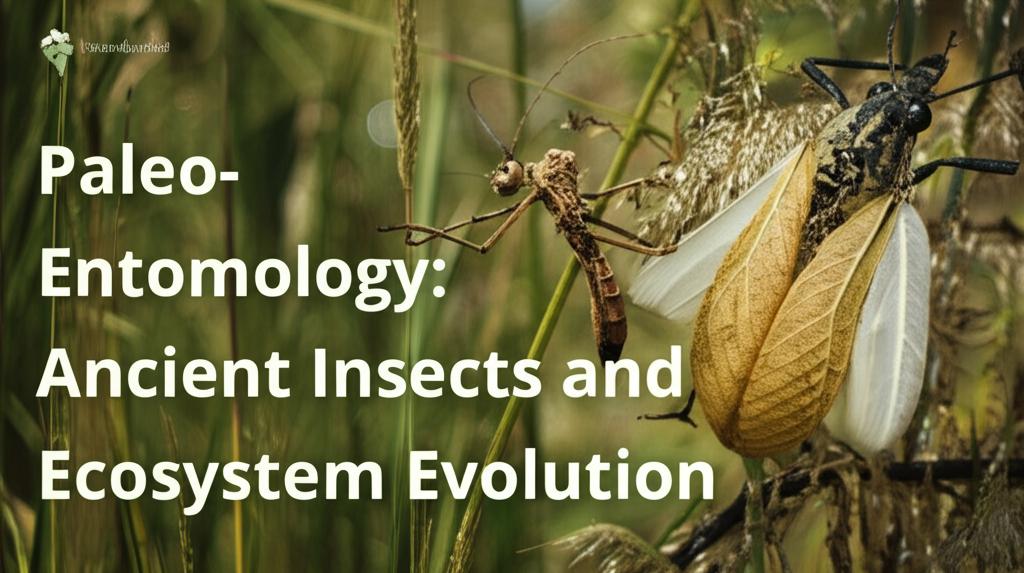Paleoentomology, the study of fossil insects, offers a unique window into the deep past, revealing the intricate co-evolution of insects and Earth's ecosystems. This field has advanced significantly, moving beyond simple descriptions of ancient arthropods to encompass a broader understanding of ancient environments, ecological dynamics, evolutionary pathways, and phylogenetic relationships.
A Glimpse into Deep Time:The story of insects stretches back hundreds of millions of years. The oldest known insect fossil, Rhyniognatha hirsti, dates back approximately 400 million years to the Devonian period. This means that insects were already diversifying well before the dinosaurs roamed the Earth. Primitive wingless insects, similar to modern silverfish and springtails, were present in the Middle Devonian, around 395 million years ago. Fossil evidence suggests their evolutionary origins might even extend further back into the Silurian period.
Key Evolutionary Milestones and Their Ecological Impact:The evolution of insects is marked by several pivotal developments that profoundly shaped their success and their role in ecosystems:
- The Advent of Wings: One of the most significant advancements in insect evolution was the development of flight. This innovation, occurring by the Carboniferous period, allowed insects to exploit new ecological niches, disperse more effectively, and escape terrestrial predators. Being the first organisms to conquer the air provided a significant survival advantage. Some theories suggest that the abundance of nutritious spores produced by early land plants might have incentivized insects to take to the air.
- Metamorphosis: The evolution of complete metamorphosis (holometamorphosis), where insects undergo distinct larval, pupal, and adult stages, was another crucial development. This life cycle strategy reduces competition for resources between juvenile and adult forms, as they often occupy different habitats and consume different foods. The nine out of 29 insect orders that undergo complete metamorphosis account for a staggering 86% of all insect species alive today, highlighting the evolutionary advantage of this complex life history.
- Gigantism in the Paleozoic: Prehistoric insects were often much larger than their modern counterparts. This gigantism is attributed to several factors, including higher atmospheric oxygen levels, warmer temperatures that boosted metabolism, and the absence of aerial predators like birds.
- Co-evolution with Plants: The relationship between insects and plants has been a long and dynamic one. Fossil evidence of insect damage on ancient plant leaves reveals that complex herbivorous feeding strategies were already in place by the Middle Jurassic, much earlier than the rise of flowering plants (angiosperms). While the specific insect species have changed over time, the types of feeding damage observed on Jurassic conifers are remarkably similar to those seen on Cretaceous flowering plants and even modern vegetation. This suggests that insects adapted their feeding styles as plant life evolved around them. Studies on fossil Eucalyptus leaves from South America, dating back 52 million years, show insect damage nearly identical to that on modern gum trees in Australia, indicating long-term tracking of food sources by insect lineages across vast geographical distances and geological timescales.
Paleoentomology is an actively evolving field, benefiting from new fossil discoveries and technological innovations:
- Exceptional Preservation: Discoveries of exceptionally preserved insect fossils continue to shed light on ancient biodiversity. For instance, recent finds in New Zealand's Miocene-aged crater lake sediments (around 15 million years old) revealed tiny whitefly puparia attached to fossil leaves in their life position. Such discoveries are incredibly rare and provide crucial data points for understanding past insect communities and their interactions with the environment. Similarly, a 47-million-year-old, almost completely preserved true cicada fossil, Eoplatypleura messelensis, was recently unearthed in Germany's Messel Pit. This find represents the earliest known example of the Cicadinae subfamily and offers insights into the evolution and spread of this diverse insect group. Another striking discovery in New York revealed a 450-million-year-old arthropod, Lomankus edgecombei, preserved in pyrite (fool's gold), showcasing intricate details of its anatomy.
- Advanced Imaging and Analytical Techniques: Modern paleoentomology utilizes sophisticated analytical and imaging techniques. Tools like synchrotron microtomography (micro-CT scanning), confocal microscopy, and Pyrolysis-Gas Chromatography-Mass Spectrometry (Py-GCMS) allow researchers to study fossil insects in unprecedented detail, even those embedded within opaque amber or rock. These technologies help in reconstructing the morphology, and sometimes even aspects of the paleoecology, of these ancient creatures.
- Integrating Fossil Data with Molecular Phylogenies: Fossil insects are invaluable for calibrating molecular clocks used in reconstructing the evolutionary relationships (phylogenies) of modern insect groups. By providing firm dates for the appearance of certain lineages, fossils help to refine our understanding of how and when different insect groups diverged.
The study of ancient insects is crucial for several reasons:
- Understanding Ecosystem Evolution: Insects have always been integral components of terrestrial and freshwater ecosystems. Their fossil record provides direct evidence of past biodiversity, ecological interactions (like herbivory and pollination), and how ecosystems responded to environmental changes and major crises throughout Earth's history.
- Reconstructing Past Environments: The types of insects found in a particular fossil deposit can provide clues about the climate and vegetation of that ancient environment.
- Tracing Evolutionary Lineages: Fossil insects help to bridge morphological gaps between extinct and extant forms, illuminating the evolutionary pathways that led to the incredible diversity of insects we see today.
- Informing Modern Conservation: By understanding how insect populations and their ecosystems responded to past environmental shifts, we can gain insights into how modern insect biodiversity might be affected by current and future climate change and habitat alteration.
Paleoentomology continues to uncover the rich and complex history of insects, demonstrating their resilience, adaptability, and profound influence on the evolution of life on Earth. As new fossil sites are explored and analytical techniques become even more refined, our understanding of these ancient creatures and their role in shaping the world's ecosystems will only continue to grow.

